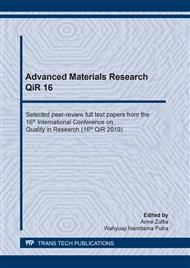[1]
H. Liao, C. Yeh and S. Lin, Ga-based submicron particle and applications,, 2018 International Conference on Electronics Packaging and iMAPS All Asia Conference (ICEP-IAAC), Mie, 2018, pp.396-398.
DOI: 10.23919/icep.2018.8374331
Google Scholar
[2]
Koh, Amanda & Mrozek, Randy & Slipher, Geoffrey. (2018). Characterization and Manipulation of Interfacial Activity for Aqueous Galinstan Dispersions. Advanced Materials Interfaces. 1701240. 10.1002/admi.201701240.
DOI: 10.1002/admi.201701240
Google Scholar
[3]
Yuriy Plevachuk, Vasyl Sklyarchuk, Sven Eckert, Gunter Gerbeth, and Rada Novakovic, Thermophysical Properties of the Liquid Ga–In–Sn Eutectic Alloy,, Journal of Chemical & Engineering Data 2014 59 (3), 757-763,.
DOI: 10.1021/je400882q
Google Scholar
[4]
Guyue Bo, Long Ren, Xun Xu, Yi Du & Shixue Dou (2018), Recent progress on liquid metals and their applications, Advances in Physics: X, 3:1, 1446359,.
DOI: 10.1080/23746149.2018.1446359
Google Scholar
[5]
Prokhorenko, V.Y., Roshchupkin, V.V., Pokrasin, M.A. et al. High Temperature (2000) 38: 954. https://doi.org/10.1023/A:1004157827093.
Google Scholar
[6]
Lyman J. Briggs, Gallium: Thermal Conductivity; Supercooling; Negative Pressure,, 1957, The Journal of Chemical Physics, 784-786, 10.1063/1.1743405 [doi], https://aip.scitation.org/doi/abs/10.1063/1.1743405.
DOI: 10.1063/1.1743405
Google Scholar
[7]
M.M. Sarafraz, Amir Arya, F. Hormozi, V. Nikkhah, On the convective thermal performance of a CPU cooler working with liquid gallium and CuO/water nanofluid: A comparative study,, Applied Thermal Engineering, Volume 112, 2017, Pages 1373-1381, ISSN 1359-4311, https://doi.org/10.1016/j.applthermaleng.2016.10.196.
DOI: 10.1016/j.applthermaleng.2016.10.196
Google Scholar
[8]
Kun-Quan Ma, Jing Liu, Nano liquid-metal fluid as ultimate coolant,, Physics Letters A, Volume 361, Issue 3, 2007, Pages 252-256, ISSN 0375-9601, https://doi.org/10.1016/ j.physleta.2006.09.041.
DOI: 10.1016/j.physleta.2006.09.041
Google Scholar
[9]
S. Santibenchakul, P. Sirijaturaporn, W. Mekprasart, W. Pechrapa, Ga-doped ZnO nanoparticles synthesized by sonochemical-assisted process,, Materials Today: Proceedings, Volume 5, Issue 6, Part 1, 2018, Pages 13865-13869, ISSN 2214-7853, https://doi.org/10.1016/ j.matpr.2018.02.030.
DOI: 10.1016/j.matpr.2018.02.030
Google Scholar
[10]
Kousar Parveen, Uzaira Rafique, Muhammad Javed Akhtar, Muthupandian Ashokumar, Ultrasound-assisted synthesis of gallium hybrids for environmental remediation application, Ultrasonics Sonochemistry,, Volume 49, 2018, Pages 222-232, ISSN 1350-4177, https://doi.org/10.1016/j.ultsonch.2018.08.013.
DOI: 10.1016/j.ultsonch.2018.08.013
Google Scholar


